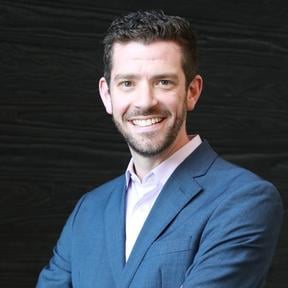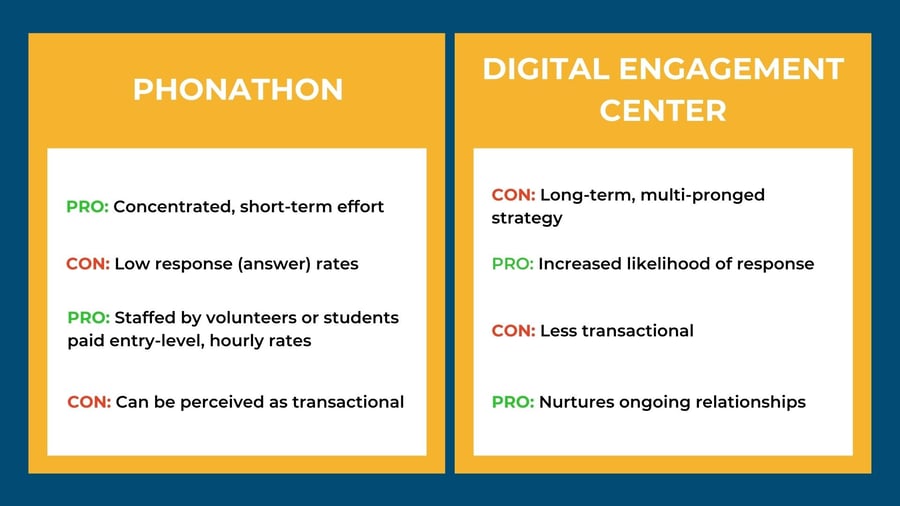From Phonathon to Digital Engagement
Evolution? or Revolution?

The great higher education fundraising debate: Should you focus on soliciting gifts or engaging donors?
Within the higher ed fundraising space, we’re hearing rumblings that the “old-school” approach of a phonathon is ineffective — and may even be a waste of time. But what replaces this approach? Is a “digital engagement center” a real change, or simply a new label for time-honored tactics?
Will approaching alumni via a multitude of channels truly engage them, or does it risk backfiring and alienating valued donors?
“It’s a little bit more complex than saying we’re moving from one to the other, replacing old with new. I don’t think there is necessarily a material difference between the two,” says Rachel Spencer, Senior Account Executive at VanillaSoft, higher-ed fundraising expert and a “self-professed phonathon enthusiast.”
But she does think there’s a trend towards thinking of digital engagement as the new approach to alumni engagement and fundraising — preferable to the phonathon.
Yet the phonathon strategy is alive and well. Plenty of institutions still execute fundraising campaigns through concentrated phone bank operations, often staffed by students who call alumni. These programs still work well for many of us. Others have transitioned to multichannel campaigns that include a phonathon component.
“What does phonathon mean today?” asks James Barnard, Associate Vice President of Digital Fundraising and Marketing for BWF, an international fundraising consulting and services company.
“It’s hard to answer without putting your own personal nostalgia on it. So many of us in the higher ed fundraising space in particular really grew up with the phonathon. That was what I did in college. We hand-dialed, we had paper call sheets — that’s how we got into the fundraising world.”
While the effectiveness of phonathons may vary from school to school, we know one thing for sure: The world looks very different from the one in which James made his first fundraising calls.
“It’s only been about 15 years since then,” he says. “But we can’t be doing the same thing. We’ve got to continually evolve. Is it a material shift? Maybe. Yes, in some ways. I think it’s a ‘yes and.’ There’s definitely still a place for that phone, but you have to bring in some other engagement tactics.”
To discuss the shifting landscape of annual giving and donor outreach, Rachel and James joined VanillaSoft CRO Darryl Praill for a conversation about what really matters in higher ed fundraising today.
Download to Read Later
Meet the Experts

James Barnard
Associate Vice President, Digital Fundraising and Marketing,
BWF
James is a fundraising strategist, community builder, and digital enthusiast who serves as Associate Vice President of Digital Fundraising and Marketing for BWF, an international fundraising consulting and services company.

Hosted by: Darryl Praill
CMO
Agorapulse
Darryl is a 2020 Top 10 SaaS Branding Expert. He was voted a Top 3 Marketer and a Top 32 Sales Leader on LinkedIn.

Rachel Spencer
Business Development Representative,
VanillaSoft
Rachel is a Senior Account Executive and fundraising subject matter expert for VanillaSoft. She specializes in phonathons and digital alumni engagement for higher education.
What's driving the shift?
 As phonathons decline in popularity, we’re seeing a move toward a more holistic approach. But why is this tried-and-tested strategy less effective now (or is it really as useful as ever)?
As phonathons decline in popularity, we’re seeing a move toward a more holistic approach. But why is this tried-and-tested strategy less effective now (or is it really as useful as ever)?
Behavioral changes
From a statistics perspective, many fundraising operations report marked declines in successful telephone contact rates over the last 20 years or so. That means there are fewer people picking up their phones at all.
“That may not be true for every organization, and it’s certainly not true everywhere,” says James. “What’s really changing is how people use their phones. They want to communicate in different ways.”
Let’s rewind to, say, the early 2000s (the pre-smart-phone era). The phone rings when you’re at the dinner table with your family. You get up from your seat, walk over to the wired landline, pick up the phone, and have a conversation (or not). But that’s not how we live anymore. We use our cell phones all day, every day — and if we don’t want to talk (or don’t recognize the number), we don’t answer.
So if we want to reach our constituents, we need to change the way we communicate.
Misplaced blame
Generally speaking, Rachel argues that phonathon campaigns haven’t always been conducted “with the level of love, care, thought, due diligence, and attention” necessary to make the most of them, although plenty of folks have been doing them right (and successfully) for many years.
Phonathons are “the only channel that allows us to really connect people — like students and alums — in a way that no other channel can,” she adds.
That’s why she thinks we tend to scapegoat the humble phone as a communication tool.
“It’s almost being treated as the cause of the issues we’ve had in the context of lazy alumni engagement over the last 20 years or so,” Rachel says. “On top of that, it happens to be the most expensive channel. So ROI is a real challenge in the context of phonathons. But I don’t think it’s fair to blame it all on phones — because any channel used poorly is destined to fail.”
Even though the phonathon has been around for a long time, it hasn’t gotten a fair shake — “hence this rebrand toward digital engagement,” she notes.
“Which does, of course, include the move towards multiple channels under one roof, versus the historic approach in which a direct marketing team does email and direct mail, a digital team does digital, and a phonathon team that only does phones.”
Rejection of ‘transactional fundraising’
Phonathon programs and other historically transactional approaches represent a path to alumni engagement that’s careless at best. But “I think we should acknowledge that in the last few decades, the fundraising ambitions for many organizations have been intensified,” says James.
“There’s been a very strong push to grow donor participation, particularly in higher ed — that ‘alumni participation’ piece.”
Expense vs. impact
“Phone is the most impactful channel if you can get someone on the phone,” Rachel says. “That’s the challenge with [the] phone, and maybe why it has been scapegoated in this way. It’s part of the reason why it becomes such an expensive channel.”
In defense of the phone (-athon, or non)
First things first: Phone calls were (and in many ways still are) the most cost-effective way to achieve a high volume of conversations.
Getting students on the phone with alumni via phonathon is a great idea — “let’s not forget that,” says James. “But it becomes transactional when you start focusing on ROI and how many calls we can get through in an hour.”
Arguably, we’ve lost sight of what is important: Building relationships, which is the opposite of transactional fundraising. We somehow bought into the idea that spending too much time on engagement was a bad thing.
What’s the real ROI?
If a development professional routinely spends 45 minutes on the phone with individual donors, that’s not a great use of staff time. However, if a student (paid a student’s hourly wage) spends that kind of time in conversation with donors, that’s “unbelievable ROI,” he adds. “We’ve just got to redefine what return means in that statement.”
We may sometimes blame the phone as a channel for the lack of relationship-based fundraising (“it’s an easy thing to blame”), but phone calls can be a fantastic way to accomplish those goals.
An overemphasis on numbers can make fundraising by phone seem transactional — and put relationships with alumni or other donors at risk.
That’s not to suggest goals and ambition aren’t important. We simply must be mindful of our other objectives, like engagement, which is key to long-term growth.
Don’t treat your donors like ATMs
 What’s the difference between a transactional call and a relationship-based call? Put simply, it’s how your donor feels when the call ends: Wow, that was a great experience — or Well, that was annoying.
What’s the difference between a transactional call and a relationship-based call? Put simply, it’s how your donor feels when the call ends: Wow, that was a great experience — or Well, that was annoying.
Rachel warns against what we call ATM fundraising: treating your alumni like human ATMs. She has even heard the graphic, cringe-worthy term piñata fundraising — “beating your alumni until money falls out of them. That is transactional fundraising,” she says.
Imagine if you asked your grandmother for money every time you called her.
“Even your grandma will eventually tell you to stop calling,” Rachel adds. “We seem to be surprised if our alumni react differently.”
The shift from phonathon (with its transactional connotations) is about thinking of alumni as people, not blank checks; seeking what she calls a “relationship-oriented journey” we “curate for them, rather than exclusively focusing on solicitation.”
Digital engagement: Evolution or revolution?
James would love to say there’s a fundraising revolution in progress. That’s not really the case, but we are experiencing a significant disruption in the ways we connect with others.
“The last couple of years have really sped things up,” he says. “The shift that we started to see [before the COVID-19 pandemic] has suddenly become dominant. … Budgets have changed. The way people work has changed. They’re at home; people are used to doing Zoom calls and are used to communicating in different ways.”
But he still thinks the move toward digital engagement is an evolution — ”a shift that’s still happening and it’s going to take some time. We’re still trying to determine what exactly it looks like.”
Five or 10 years down the road, however, he’s confident the fundraising landscape won’t look the same as it does today.
At the moment, we know a few things for sure:
Ding, dong — the phone isn’t dead
 Far from it: Phones still have their place in our multichannel communication strategy.
Far from it: Phones still have their place in our multichannel communication strategy.
However, our definition of fundraising via phone has changed, says James.
Some of us like to talk on the phone, and others avoid it at all costs. Some people prefer text messages; some favor email; others respond quickly to messages on social media but are hard to reach otherwise. What do all have in common? They’re all accessible on our phones.
“I’m addicted to my phone, and it’s a problem. I have a 15-month-old daughter who thinks my phone is the coolest toy in the house. She has no idea what it does. All she knows is dad plays on it constantly. It’s with me all the time. … It’s the single most important object I own.”
That’s why the phone as a means of communication is emphatically not dead. It can’t possibly be dead. But we have to meet our donors where they are (and how they like to interact).
James is someone who chooses texting whenever it’s possible. He recently bought a house — almost entirely via text messages (and a remote video tour) with his real estate agent.
“[The] phone can’t possibly be dead,” he adds. “But here’s one thing I would say about that: For higher ed in particular, you have donors and alumni who are in their 80s as well as those who are in their 20s. Are you communicating with them the same way?”
Remember: Change is good
If you’re a little (or a lot) nervous about phonathons becoming only one tool in a larger arsenal, that’s understandable. But it’s also exciting, says James.
“There’s a lot of opportunity here. There’s a lot of cool stuff you can do now. You may not understand it, or you may not know it all. However, there are tons of resources out there to learn how you can use these tools.”
Tracking can be tricky
In the realm of nonprofit fundraising, especially annual giving for higher education, “we like to track everything,” James notes. “We want to be able to say this gift happened because of the phone or this gift happened because of direct mail. But we have to get comfortable knowing that we can’t track everything the way we used to.”
We also need to understand that everything in the multichannel toolset has an impact, even if it’s in aggregate. We should seek out ways to measure individual strategies when we can.
“But ultimately, you’re not going to be able to pinpoint every [method of giving each] gift,” James adds.
He thinks we should also remember to “enjoy doing it — this is still personal outreach at scale. It’s still this idea that people give to people. It’s a fundraising model that really goes back to our roots, and I think that’s a good thing. I think it’s a really positive shift.”
Doing digital engagement right
Even traditional phonathon approaches usually segment potential donors according to demographics like age, language, and geography. Sometimes they’re targeted by programs or interests as well.
“We should be looking at people’s interests and their motivations,” James says.
A persona-based approach works well when it’s used with just one channel, the phone. But today’s modern software platforms can segment audiences even further. A multi-channel approach is baked right in. However, digital engagement works best when it’s deployed with a people-first mentality. Our experts share these best practices:
Know (and respect) your audience
Are you sending one appeal letter to everyone? Is the text of your latest email simply a copy of that letter? Do you have a script for your phone calls that basically sounds the same?
Higher education organizations have audiences that vary widely in their preferences. An alumna in her 80s probably communicates quite differently than her twentysomething sorority sister.
That’s why we should constantly ask our constituents what works best for them.
“We have to think about the long-term,” says James. “One of the things that’s very unique to higher ed is that if you are very focused on alumni fundraising, you have a finite community. You can’t afford to just churn and burn through your donors.”
That reality is in stark contrast to other kinds of asks — like those in a political fundraising campaign, for example.
“That’s got a two-year shelf life,” James notes. “Get as many gifts as you can, send 10 emails a day. Because after that campaign's over, who cares?”
But your community of graduates is fixed.
“They are your alumni, like it or not,” he adds. “So if you upset them early on, that’s a problem in the long term.”
Rachel agrees: “A university cannot buy more alumni. If a sales team really messes up, it may be costly for them, but they can find more prospective customers or leads. A university can’t do that. And it takes a really long time to rebuild a relationship.”
It reminds her of the adage that says it takes a lifetime to build a good reputation but just moments to destroy one. Right now, many institutions find that their relationships with alumni are broken — “and everybody’s scratching their head, thinking, How do we fix this … when we’ve completely alienated a significant chunk of our alumni population?"
Say no to stereotypes
One of those chunks, so to speak, is young alumni. Perhaps they’re responsible for the flawed claim that the phone is dying. Millennials and even Gen-Xers don’t respond particularly well to phone-based solicitation or engagement. However, that’s “probably an oversimplification,” says Rachel.
“It’s important to look at this on an individual level. I don’t think it’s fair or correct to completely generalize within a particular age group.”
She recommends inviting your donor base to specify by which channels they enjoy hearing from you, especially because some people will only give via phone.
Some universities report stagnating results from phonathons, but a large percentage of their donors only give when they get that phone call each year. Still, plenty of phonathon programs dial the folks who repeatedly tell their alma mater that they do not want phone calls. Investing any time, money, or effort attempting to get them to respond positively via phone is not just a waste of resources; it’s a gamble on the relationship itself.
Always use multiple channels
 While Rachel advises we “get granular with channels and preferences,” James reminds us that a multichannel approach is still a must.
While Rachel advises we “get granular with channels and preferences,” James reminds us that a multichannel approach is still a must.
Members of our communities may report their preferences but never respond through the channels they choose. Many people need several different modes of communication for a message to really resonate. So while we can’t rely solely on a phone program, we can’t expect an email-only campaign to work either.
No matter how many channels we use, our efforts should be “coordinated and individualized,” James argues.
Get buy-in for impact
Because phone campaigns can be taxing on a number of resources, Rachel recommends getting leadership on board with multichannel communication. Emphasize how other modes of outreach are less expensive and have the potential to be more successful.
“[The] phone is only impactful if the person actually picks up,” she adds. "A series of missed calls is only impactful probably in terms of annoying your desired target.”
Try, try again (but differently)
Do you always start your outreach with a phone call, followed by another phone call … and a few more phone calls? Or is your approach via phone, with a side of texting?
Perhaps you can try something new: Start with an email or a text message, with a phone call later on in the cadence.
“We’re seeing some really exciting stuff there,” says James of this approach. “You just have to test to see what works, because it’s certainly not going to be a one-size-fits-all playbook for every organization.”
Even within an organization, certain cadences will work better for different audience groups. The upside to digitally-focused campaigns is that most engagement software allows for easy siphoning of certain audience subsets into more (or less) phone-oriented channels.
James notes that we shouldn’t be afraid to move someone back to a digital channel if repeated calls go unanswered. In fact, we should never think of one channel as the sole mode of communication with anyone. Instead, we should “play with various channels in a way that is more dynamic and creative,” he says. “Work out what’s most effective and engaging for each individual, as well as who is most engaged with you.”
Then, consider prioritizing those folks in your phone fundraising efforts, in the hope they will be more likely to pick up the phone and receive the potential impact of those calls.
Make over your mindset
Engaging your audience with a multichannel approach is not unlike dating in our modern era. Many couples connect on an app and message each other for a while before adding another method of communication. Perhaps they move to social DMs or emails. Text messaging is even more personal and direct because you’re trusting them with your phone number. Some people chat on video calls before they even think about meeting in person.
“That’s representative of how the world has changed,” says James. “We have to think about where the relationship begins.”
The bond between a student and their school is usually forged on campus during a meaningful, transformative part of their life. That’s an invaluable asset for fundraisers — the ultimate warm intro, so to speak.
But the development team must take over that relationship with care.
“It’s really important to let that build out in a natural way, with intentionality behind it,” James says. “Have a structure and a plan.”
Try something new
Here’s an idea that’s gaining traction in higher ed phonathons: When a student and an alum connect on a phone call that results in a donation, assign the student to that alum. Three to six months later, the same student calls to thank them or renew their monthly gift. It’s a win-win for both alumni and student callers.

Conclusion: ‘Personal outreach at scale’
“There’s not necessarily a material difference between [the] phonathon and digital engagement,” says Rachel. “Many people have been doing digital engagement under a phonathon header for some time. And some are still doing what we refer to as the old-school approach to phonathon — under this new brand of digital engagement.”
What we call our fundraising outreach isn’t all that important. The actions we take, and how they’re taken, are what truly matters. However, rebranding phonathon strategy as digital engagement gives us the opportunity to reimagine its potential. Constructive criticism of past phonathons can only help us to design them better in the future.
No matter what tools or methods we use to reach our communities, we have to keep our objectives at the forefront of our campaigns.
James once heard a speaker at a conference say: Don’t chase the tools, chase the goals.
Sometimes, we as fundraisers get distracted by shiny new things — whether they’re software applications, social media platforms, or simply ill-conceived axioms (like “the phone is dead”).
“I’m fine if you want to use phonathon. That’s totally cool,” James says. “It’s got a special place in my heart. What I like about digital engagement center isn’t the word digital, it’s engagement.”
That’s the real shift — a mindset about building community and nurturing relationships, an “engagement first” approach. We need to remember that people give to people, and the advantage of technology is that it empowers “personal outreach at scale.”
Call it the Holy Grail, if you will. It’s “what we’ve always tried to do in fundraising,” James adds. “And it’s more important today in 2022 than ever before.”
The Evolution from Phonathon
to Digital Engagement
Will approaching your alumni via a multitude of channels rather than just by phone serve to truly engage? Or does it risk backfiring and alienating your alumni population further? What’s the right answer?!
Watch as James Barnard and Rachel Spencer share their insight around the impact of digital engagement in phonathon campaigns. Watch on-demand now!